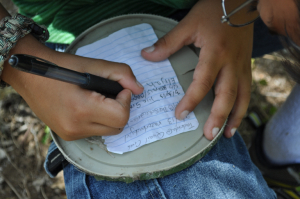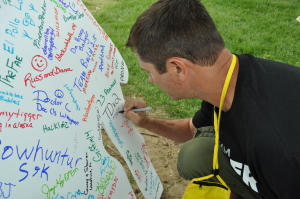There are many log types that cachers face when posting online and it might get a bit confusing. Choosing the correct log type can make a big impact on the history, status, and perceived difficulty of a Geocache. Here are the log types with a brief discussion about when to use each.
- Found It – Use this log type when you have found the container (first time only) and signed
 the physical log. It is appropriate to use the Found It log type when the paper log is too wet to sign or the cache container is damaged so much that it will not open. These particular events warrant an additional Needs Maintenance type log. You may be granted permission to log as found by the Cache Owner (CO) if some extenuating circumstances preclude you from obtaining the physical log.
the physical log. It is appropriate to use the Found It log type when the paper log is too wet to sign or the cache container is damaged so much that it will not open. These particular events warrant an additional Needs Maintenance type log. You may be granted permission to log as found by the Cache Owner (CO) if some extenuating circumstances preclude you from obtaining the physical log. - Didn’t Find It – The dreaded DNF log. If you did NOT find the cache container then you will select this type. Many cachers hang their head in shame when submitting this type of log. My philosophy about this is that the DNF log type is a vital part of the game. The CO and other cachers need to know that someone couldn’t find the cache. One or two isolated DNF logs are par for the course, but a series of them may indicate that the container has gone missing or has been incorrectly placed. Maintenance of caches is an important responsibility and we all can contribute to keeping the caching community aware of a Geocache’s status. Always log your DNFs.
- Write Note – This option is a catch-all for any comments you may have regarding a cache
 container, its placement, hazards, etc. when you want to say something without logging it as found or not found. If you have already logged the cache as found previously and you return (with a group of cachers , for instance), use the Write Note type log to report that you found it again. This will ensure that your stats about UNIQUE cache finds is always accurate. It is also acceptable to use the Write Note log type if you forgot to “Visit” a trackable in a cache (although, editing your Found It log and selecting the trackable is the preferred method) Try to keep your notes pertaining to that specific cache listing (Use online forums for generic Geocaching discussions) Don’t use this log type to report that you did not find the cache.
container, its placement, hazards, etc. when you want to say something without logging it as found or not found. If you have already logged the cache as found previously and you return (with a group of cachers , for instance), use the Write Note type log to report that you found it again. This will ensure that your stats about UNIQUE cache finds is always accurate. It is also acceptable to use the Write Note log type if you forgot to “Visit” a trackable in a cache (although, editing your Found It log and selecting the trackable is the preferred method) Try to keep your notes pertaining to that specific cache listing (Use online forums for generic Geocaching discussions) Don’t use this log type to report that you did not find the cache. - Needs Archived – Use this type of log only if it is completely obvious that the container is missing AND the CO is missing. Also, if you encounter a land owner, law enforcement officer or other issue requiring immediate action (security, too close to a government facility, or airport), use the Needs Archive log type to alert the CO and Reviewer. There seems to be an epidemic of Geocachers selecting this log type on their first failed attempt to find a cache. I guess their thinking is if I can’t find it, it must be missing. Only use this log category in extreme instances!
- Needs Maintenance – When a cache has a broken, leaking, wet or full log or a missing container use the Needs Maintenance log type. Log your find first by submitting the Found It log then click on Log your visit again and selecting the Needs Maintenance log type. Include details about how the cache is in need of repair so that the CO will know what to bring with them. This will also alert other cachers that there is a problem and they can plan accordingly. Some cachers will avoid the cache until maintenance has been completed while others will help the CO out by replacing the wet log or cracked lid. When you submit a Needs Maintenance log type the cache listing will get “flagged” with the red wrench (or spanner in the UK) that will remain until the CO submits a Owner Maintenance type log. The wrench attribute will prevent the CO from
publishing any new caches until the discrepancies are cleared. Don’t let this deter you from reporting the cache if it needs attention. You will be doing everyone a favor. The Needs Maintenance option is not available if a cache is disabled. - Will Attend/Attended – These two log types are for event caches. Use the Will Attend log type before the event to show the event hosts that you will (or might) attend so that they can plan accordingly. After you go to the event, use the Attended type to officially log your “find” of the event. Yes, it counts as finding a cache!!!
- Webcam Photo Taken – This type of log pertains only to Webcam caches. Use this log type to record your find after you have taken your photo at a Webcam cache.
In addition to the above log types, there are a few others that are available to Cache Owners
- Archive – Use the Archive log type when you need to remove a published cache from public view permanently. This option is used by a Cache Owner who cannot continue to maintain a cache for a number of reasons (location no longer viable, CO moves away from the area, etc.). The Archive log type should be used when instructed by a cache Reviewer to archive the listing (land owner complaint, Law Enforcement direction, etc.).
- Temporary Disable Listing – This is probably the most common log type for a Cache Owner to use through the course of a cache’s life-cycle. It is used when the cache is temporarily unavailable to be found by cachers. This could include: missing/broken container, construction near the cache’s Ground Zero, inaccurate coordinates, wet/missing log, unsafe conditions that could create a danger to those who seek it. Use this log type when the status is temporary.
- Owner Maintenance – When a finder of a cache logs a cache as Needs Maintenance it flags the Cache Owner’s profile so that they cannot hide a new listing until the issue with the flagged cache is resolved. After the CO has performed the required maintenance, he submits a Owner Maintenance log to let the caching community know it is ready to find again, and it also removes the restriction on their account.
New cachers sometimes change the future direction of Geocaches just by selecting the wrong log type. Care should be taken to ensure an accurate story of the cache’s status is reflected to its world-wide audience.
